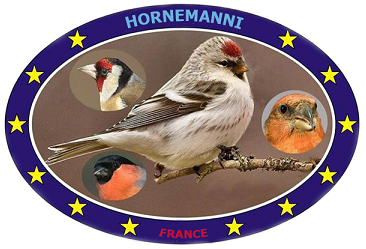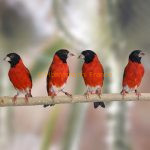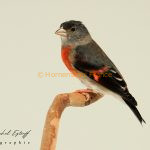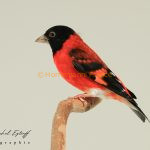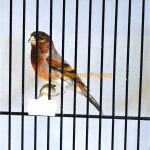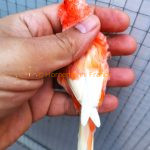The Venezuelan red Siskin
The Venezuelan red Siskin ,Spinus cucullatus, (Swainson, 1820)
Order : Passeriformes
Family: Fringillidae
Genus: Spinus
Zoological Name: Spinus cucullatus
Geographical distribution: Venezuela, Colombia and Guyana.
William John Swainson was a British biologist (ornithologist, entomologist, malacologist, etc.) and artist, born on 8 October 1789 in St. Mary Newington (London) and died on 6 December 1855 in Fern Grove, New Zealand. He classified the red Siskin in 1820 under the scientific name Carduelis cucullata.
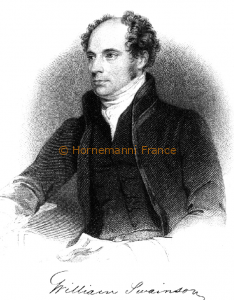
Illustration ,WILLIAM SWAINSON,1820
Unfortunately, this species is endangered in its natural habitat, having been the victim of poaching for over 100 years. The Venezuelan Red Siskin population is currently estimated at between 1,500 and 7,000 individuals. This species is considered endangered due to a very rapid demographic decline caused by poaching for the caged bird trade. In addition, males of this species have been used for several years to transmit the red colour to the domestic Canary Serin through interspecific hybridisation.
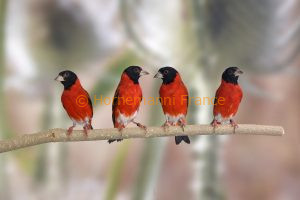
Photo: copyright Guy Doumergue, Udine 2022.
The Venezuelan Red Siskin is a protected species because of its vulnerability in its natural habitat.
Legal status of the Venezuelan Red Tarin
International protection status: It is listed in Appendix I of the Convention on International Trade in Endangered Species of Wild Fauna and Flora (CITES), also known as the Washington Convention.
Legal protection status within the European Community: It is listed in Annex A of Regulation (EC) No 338/97, and in Annex X (10) of Regulation (EC) No 865/2006.
Legal status for keeping in France: The Venezuelan Red Tarin is considered to be a non-domestic species. It is listed in Annex 10 of EC Regulation 865/2006, which means it can be kept more flexibly due to its widespread use in controlled breeding in Europe. It is also considered easy to care for, and there are no imports of this species into the European Union.
However, keeping this species is subject to a quota established by the Ministerial Order of 8 October 2018, compulsory marking, entry in the entry/exit register (CERFA no. 1597001), the marking declaration (CERFA 1596901) and compulsory entry in the national identification file, the I-FAP. In the event of a transfer of this species, it is necessary to provide a description sheet of the species’ requirements as well as a transfer certificate, including the price and meeting the criteria defined by the Ministerial Order of 8 October 2018.
Legal status for keeping domestic varieties: The brown and pastel varieties of the Venezuelan Red Siskin are considered to be domestic. They are listed in the Ministerial Order of 11 August 2006 and may be kept without any special formalities.
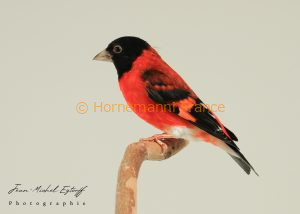
Male Classic Red Siskin
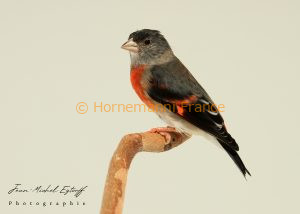
Female Classic Red Siskin
Dr Arthur G. Butler describes the characteristics of certain American Siskins imported into Europe around 1890.
The Yarrell’s Siskin (Spinus yarrelli) is a Brazilian bird that is rarely imported, but has been in the possession of several enthusiasts. It has a bright yellow belly, olive upperside, black wing and tail markings and a black bonnet on the head. The following American species, resembling the previous ones, have been imported: the Siskins of Arkansas (S. psaltria), of Colombia (S. columbiana); then black birds, with yellow on the lores, rump and belly: the Yellow-bellied Siskins (S. xanthogaster), with yellow rump (S. uropygialis); then the Black-headed Siskin (S. icterina), an excellent singer of which I brought back a specimen from Argentina in 1893. Unfortunately, it is a delicate bird, and mine, like the others imported, did not live long.
Next comes the Venezuelan Red Siskin (S. cucullata); it is the prettiest species in the family. It is very small, and although it breeds in aviaries, it is difficult to acclimatise when it first arrives. Once accustomed, it lives perfectly well. The male has vermilion-red plumage with a black head and black wing and tail markings. The female is ash-grey, with black on the wings and tail, and a pale red tinge on the wings and breast. Finally, the Pine Siskin (S. pinus) of North America, though dull in plumage, has a melodious voice. Page 193, The birds of Brinsop court in 1920, By HUBERT DELAVAL ASTLEY. REVUE D’HISTOIRE NATURELLE APPLIQUEE. Year 1920
Breeding
In a controlled environment, crosses were made for several years between the Venezuelan Red Siskin and its close European relatives, such as the Alder Siskins as well as other American Siskins. The aim was to introduce colour variations already present in these species. However, this practice had the unfortunate consequence of genetically polluting birds born in captivity. Although breeding these hybrids may seem interesting, it would have been wiser to restrict this practice in order to maintain pure, unaltered specimens, particularly for conservation efforts. If this approach had been better supervised and limited, it could have helped to preserve this species, which is in danger of extinction in its natural habitat. Unfortunately, however, most Red Siskins born in captivity in Europe are genetically altered and cannot be used in programmes to boost the population.
Maintaining and breeding this species is relatively straightforward, and reproduction is generally fairly easy, even for novices. However, some common breeding difficulties can be encountered. It is important to note that this species is known to be sensitive to sub-zero temperatures. It is therefore advisable to regulate temperature and light appropriately to obtain good results. However, experienced breeders have managed to acclimatise this species to our climate by allowing the birds to spend the winter in an outdoor aviary, exposed to natural light. This species has been hybridized with the domestic Canary Serin, making it possible to introduce the orange lipochromic colour (the coloured bird will have the red lipochromic colour).
Let’s go back in time to 1920.
By Hubert Delaval Astley
“Last spring, during a trip to Italy, I stopped off in Paris and, of course, accompanied Mr Delacour to the bird dealers. One of the birds I bought was one of these Red Siskin and Canary Mules, which I like for their pretty orange colour and pleasant song. A little later, in Milan, as I was buying seeds in the only bird shop I could find, the shopkeeper said to me: “Would you like a Red Mullet? I replied that I already had one. He then asked me where I’d bought it, and I replied, “From Travella in Paris”. His reply surprised me: “So, it’s from home! I had taken the Mule back to its country of origin! I also bought the one he offered me, which he kept carefully on the first floor, away from the common bird population Page 193, The birds of Brinsop court in 1920, By HUBERT DELAVAL ASTLEY. REVUE D’HISTOIRE NATURELLE APPLIQUEE. Year 1920
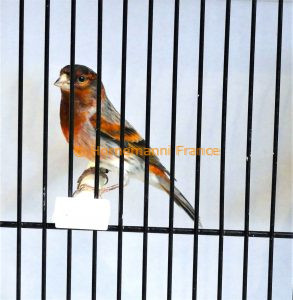
Photo Copyright Kamel Latreche Championnat de France à Palavas-les-Flots, Hybride Red Siskin X Canary.
Hans Duncker (1881-1961), one of the first avian genetic scientists, and the great breeder Karl Reich (1885-1970) collaborated to better understand the genetic transmission system of colour mutations, thus contributing to the development of avian breeding and science.
Collaboration between scientists and breeders played a crucial role in these advances. Duncker and Reich carried out important selection experiments to establish the pattern of inheritance of variegation and other traits in canaries.
Duncker also embarked on an ambitious project to create a red canary by crossing canaries with the Venezuelan Red Siskin (Carduelis cucullata). This initiative made it possible to identify the gene responsible for the red colour in canaries, marking the first experience of transgenesis in ornithology. However, truly red canaries were only produced in England in the 1950s.
This collaboration between a genetic scientist and a passionate breeder led to a better understanding of the genetic mechanisms underlying colour variations in birds, and paved the way for new advances in avian breeding.
Portuguese researchers conducted a recent genetic study using DNA sequencing techniques. Here are the results:
Their conclusions indicate that two genes have been transferred from the red tarin to the canary. These genes are located on two different chromosomes, chromosome 8 and chromosome 25. The gene on chromosome 8 is responsible for converting yellow pigment into red pigment, both in the liver and in the skin. The second gene, located on chromosome 25, plays a role in fixing this red pigment to the skin and feathers.
https://www.ncbi.nlm.nih.gov/pmc/articles/PMC5125026/
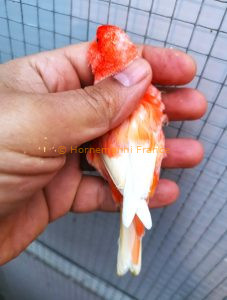
Photo Copyright Kamel Latreche, female red-winged domestic Canary Serin.
Conclusion:
In the past, we have found that collaboration between breeders and scientists has been beneficial in better understanding the biology and hereditary transmission of colours and traits in birds. Hobby breeding is particularly interesting and popular in France, and I do it myself. However, we have observed that, in the absence of supervision, most Red Siskins in Europe today have genetic alterations that prevent them from taking part in population enhancement programmes.
However, if a few French breeders had maintained the natural form of the species by avoiding inbreeding, avoiding the introduction of mutations through hybridisation, and ensuring appropriate genetic mixing, French breeders could have played a crucial role in preserving this species in its natural habitat.
https://www.redsiskin.org/understanding-the-red-siskin/
This NGO is actively involved in preserving the species in its natural environment. Jean Michel Eytorff, a judge with the OMJ (World Organisation of Judges), amateur ornithologist and amateur wildlife photographer, has worked closely with this association. He shared our breeding techniques and encouraged breeders and ornithological associations to make donations. I myself contributed by making a donation to this association as a breeder committed to biodiversity.
Kamel Latreche
Head of regulations and protection Hornemanni France
